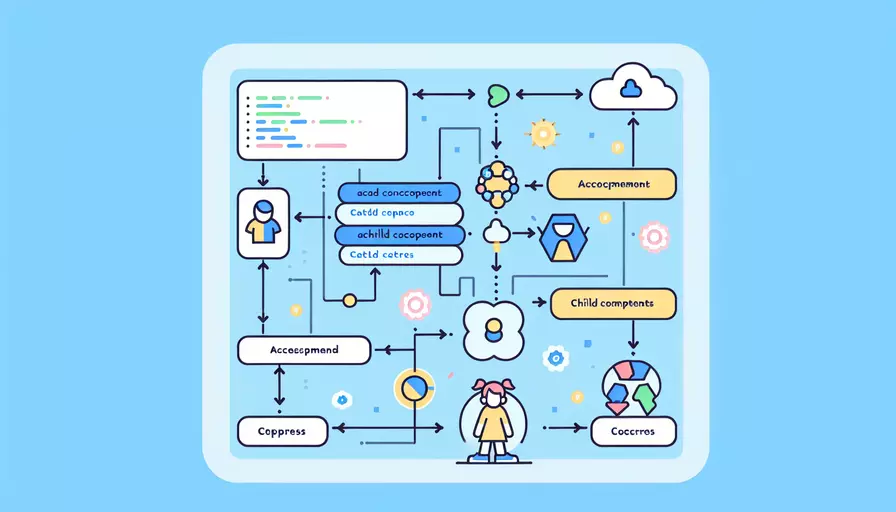
在Vue中,可以通过以下几种方法来获取子组件:1、使用$refs属性,2、使用事件通信,3、使用Vuex或其他状态管理工具。这些方法允许父组件和子组件之间进行数据和方法的交互,从而实现更复杂的功能和逻辑。
一、使用`$refs`属性
Vue提供的$refs属性是获取子组件最常用的方法之一。$refs允许父组件直接访问子组件的实例,从而调用子组件的方法或获取其数据。
步骤:
- 在子组件上添加
ref属性。 - 在父组件中通过
this.$refs访问子组件实例。
示例代码:
<!-- 子组件 Child.vue -->
<template>
<div>子组件内容</div>
</template>
<script>
export default {
name: 'Child',
methods: {
sayHello() {
console.log('Hello from Child Component');
}
}
}
</script>
<!-- 父组件 Parent.vue -->
<template>
<div>
<Child ref="childComponent" />
<button @click="callChildMethod">调用子组件方法</button>
</div>
</template>
<script>
import Child from './Child.vue';
export default {
components: { Child },
methods: {
callChildMethod() {
this.$refs.childComponent.sayHello();
}
}
}
</script>
二、使用事件通信
事件通信是一种更加解耦的方式,适用于子组件向父组件发送消息。父组件可以监听子组件发射的事件,并在事件处理器中执行相应的操作。
步骤:
- 在子组件中使用
$emit发射事件。 - 在父组件中使用
@事件名监听子组件发射的事件。
示例代码:
<!-- 子组件 Child.vue -->
<template>
<div>
<button @click="notifyParent">通知父组件</button>
</div>
</template>
<script>
export default {
name: 'Child',
methods: {
notifyParent() {
this.$emit('notify', 'Hello from Child');
}
}
}
</script>
<!-- 父组件 Parent.vue -->
<template>
<div>
<Child @notify="handleNotification" />
</div>
</template>
<script>
import Child from './Child.vue';
export default {
components: { Child },
methods: {
handleNotification(message) {
console.log(message);
}
}
}
</script>
三、使用Vuex或其他状态管理工具
对于更复杂的应用,尤其是当多个组件需要共享状态时,使用Vuex或其他状态管理工具是推荐的方式。Vuex提供了一个集中式的存储库,可以在父组件和子组件之间共享数据和方法。
步骤:
- 在Vuex状态中定义共享的数据或方法。
- 在父组件和子组件中分别通过
mapState或mapActions访问和操作共享状态。
示例代码:
// store.js
import Vue from 'vue';
import Vuex from 'vuex';
Vue.use(Vuex);
export default new Vuex.Store({
state: {
message: 'Hello from Vuex'
},
mutations: {
updateMessage(state, newMessage) {
state.message = newMessage;
}
},
actions: {
changeMessage({ commit }, newMessage) {
commit('updateMessage', newMessage);
}
}
});
<!-- 子组件 Child.vue -->
<template>
<div>
<p>{{ message }}</p>
<button @click="changeMessage('Hello from Child')">修改消息</button>
</div>
</template>
<script>
import { mapState, mapActions } from 'vuex';
export default {
computed: {
...mapState(['message'])
},
methods: {
...mapActions(['changeMessage'])
}
}
</script>
<!-- 父组件 Parent.vue -->
<template>
<div>
<p>{{ message }}</p>
<button @click="changeMessage('Hello from Parent')">修改消息</button>
<Child />
</div>
</template>
<script>
import { mapState, mapActions } from 'vuex';
import Child from './Child.vue';
export default {
components: { Child },
computed: {
...mapState(['message'])
},
methods: {
...mapActions(['changeMessage'])
}
}
</script>
总结
在Vue中获取子组件的方法有多种,包括使用$refs属性、使用事件通信、以及使用Vuex等状态管理工具。每种方法都有其适用的场景和优缺点:
- $refs:适用于需要直接访问子组件实例的方法调用。
- 事件通信:适用于子组件向父组件发送消息,解耦合。
- Vuex:适用于复杂的应用,多个组件共享状态。
根据具体需求选择合适的方法,可以帮助更好地管理组件之间的交互和数据流。为了更好地理解和应用这些方法,建议结合实际项目进行实践,并阅读官方文档获取更多详细信息。
相关问答FAQs:
1. 如何在Vue中获取子组件的引用?
在Vue中,获取子组件的引用有多种方法。以下是两种常用的方法:
方法一:使用ref属性
你可以在父组件中使用ref属性来获取子组件的引用。首先,在子组件上添加一个ref属性,然后在父组件中使用this.$refs来访问子组件。例如:
<template>
<div>
<child-component ref="childRef"></child-component>
</div>
</template>
<script>
import ChildComponent from './ChildComponent.vue';
export default {
components: {
ChildComponent
},
mounted() {
const childComponentRef = this.$refs.childRef;
// 使用childComponentRef来访问子组件的方法和属性
}
}
</script>
方法二:使用事件和自定义事件
你可以在子组件中定义一个自定义事件,并在父组件中监听该事件。当子组件触发该事件时,父组件就可以获取子组件的引用。例如:
<!-- 子组件 -->
<template>
<div>
<!-- 触发自定义事件 -->
<button @click="notifyParent">触发事件</button>
</div>
</template>
<script>
export default {
methods: {
notifyParent() {
this.$emit('child-event', this);
}
}
}
</script>
<!-- 父组件 -->
<template>
<div>
<child-component @child-event="getChildRef"></child-component>
</div>
</template>
<script>
import ChildComponent from './ChildComponent.vue';
export default {
components: {
ChildComponent
},
methods: {
getChildRef(childRef) {
// 使用childRef来访问子组件的方法和属性
}
}
}
</script>
2. 如何在Vue中通过子组件的名称获取子组件?
如果你想通过子组件的名称获取子组件,可以使用$children属性和$refs属性。
方法一:使用$children属性$children属性是一个数组,包含了当前组件的所有子组件实例。你可以通过遍历$children来找到特定的子组件实例。例如:
<template>
<div>
<child-component></child-component>
</div>
</template>
<script>
import ChildComponent from './ChildComponent.vue';
export default {
components: {
ChildComponent
},
mounted() {
const childComponent = this.$children.find(child => child.$options.name === 'ChildComponent');
// 使用childComponent来访问子组件的方法和属性
}
}
</script>
方法二:使用$refs属性$refs属性是一个对象,包含了组件中所有带有ref属性的子组件或DOM元素。你可以通过$refs来访问特定的子组件。例如:
<template>
<div>
<child-component ref="childRef"></child-component>
</div>
</template>
<script>
import ChildComponent from './ChildComponent.vue';
export default {
components: {
ChildComponent
},
mounted() {
const childComponentRef = this.$refs.childRef;
// 使用childComponentRef来访问子组件的方法和属性
}
}
</script>
3. 如何在Vue中通过事件从子组件获取数据?
在Vue中,子组件可以通过自定义事件向父组件传递数据。以下是一个通过事件从子组件获取数据的示例:
<!-- 子组件 -->
<template>
<div>
<button @click="sendData">发送数据</button>
</div>
</template>
<script>
export default {
methods: {
sendData() {
const data = '这是子组件发送的数据';
this.$emit('child-event', data);
}
}
}
</script>
<!-- 父组件 -->
<template>
<div>
<child-component @child-event="getChildData"></child-component>
</div>
</template>
<script>
import ChildComponent from './ChildComponent.vue';
export default {
components: {
ChildComponent
},
methods: {
getChildData(data) {
// 在父组件中获取到子组件发送的数据
console.log(data);
}
}
}
</script>
在子组件中,通过$emit方法触发一个自定义事件,并传递数据作为参数。在父组件中,使用@child-event来监听子组件触发的事件,并在回调函数中接收子组件传递的数据。这样,父组件就可以从子组件中获取数据了。
文章标题:vue如何获取子组件,发布者:不及物动词,转载请注明出处:https://worktile.com/kb/p/3620966

 微信扫一扫
微信扫一扫  支付宝扫一扫
支付宝扫一扫 